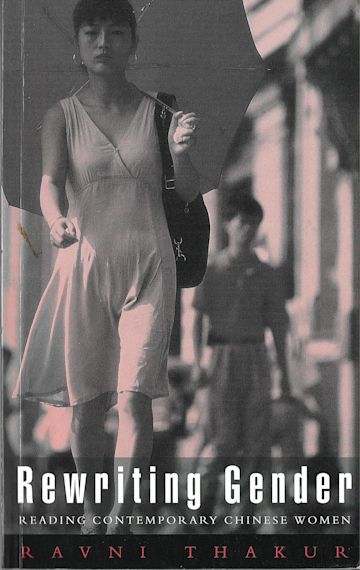Taal Seth, Research Intern, ICS

Book Review: Rewriting Gender: Reading Contemporary Chinese women by Ravni Thakur, London, Cynthia Street, 1997, published by Zed Books Ltd, ISBN 1-85649-410-1 (Paperback)
Through Rewriting Gender, Ravni Thakur conducts research on the lives of women in post-Mao Chinese society. She imagines gender roles as discursive practices, reproduced through their representations in literature and other texts. To this end, she conducts discourse analysis of prevalent works of literature written by women writers as well as their literary criticism that were published between the end of the Cultural Revolution (1976) and the suppression of pro-democratic protests at Tiananmen Square (1989). The author chooses this timeline as it coincides with the rise in the number of women authors at this time. Moreover, it allows her to study reflections on ideals of gender set in place by Confucianism, socialist realism as well as by the changing face of Chinese society under Deng Xiaoping.
The central theoretical argument of the book is that the
social institution of gender is a discursive practice that gets produced by and
reproduced in literature. Thakur employs Michel Foucault’s concept of knowledge
production as the basis of her theoretical framework. To apply this work in her
particular research, she uses Pierre Bourdieu’s tenets of literary analysis and
knowledge production within the ‘the literary field’ for discourse analysis of
Chinese literature. She creates a distinction between orthodox and heterodox
thoughts on gender roles and the position of women in society, which is
reflected in the prevalent literature of the period. She observes that the
theme of socialist realism was enforced in orthodox literature. Through
socialist realism, Thakur refers to a literary theme wherein characters within
a story are expected to stand as role models for the readership, and the
stories are supposed to deliver a moral message in line with the tenets of
Chinese socialism. This is done on the basis of Pierre Bourdieu’s theory of
‘discourses of power’ (which she relates with orthodox discourses in Chinese
literature) and ‘discourses of resilience’ (represented in the heterodox gender
discourse in Chinese literature).

The introduction of the book highlights its two main questions: what is the orthodox discourse on gender roles and how does heterodox discourse challenge it? The book is divided into two parts to answer these questions. Thakur uses the first chapters of each part to lay down the theoretical background. In the first part of the book, ‘Orthodox Gender Discourse and the Literary Field,’ she reviews secondary literature on the discourse of ‘labour heroines’ championed during the Great Leap Forward and the Cultural Revolution, when the popular political attempt was to revive and accelerate economic growth within and through Chinese society. In contrast was the post-Cultural Revolution period, when women’s natural worth was founded in motherhood and familial loyalties.
Thakur argues that the most obvious signifier of orthodox thought in Chinese literary circles is the very attempt to club women writers together and to assert that their work has a distinct voice from men’s. She primarily reviews literary criticisms on the works of women authors such as Ru Zhijuan, Zong Pu, Zhang Jie, Shen Rong etc. and argues that this literature is stuck in a prison architectured by China’s party-state, which limited authors from exploring uncharted themes. Thakur also argues that literary criticism for women’s work falls short, since there was no framework in place to critique women’s work; this is because of the sudden rise of women authors in China along with the very small number of women critics to prepare a framework.
The second part of the book titled ‘Responses to Gender Discourse,’ engages with literary works that display heterodox thought. In this part, the author reviews works of writers whose criticism was analysed in the first part. Specifically, she studies characters and settings, the theoretical model for which is outlined in Chapter 4 (A Methodology for Character Analysis). Through this section, she breaks down the myth of the nuxing wenue or women’s writings, by bringing forth the divergent themes, stories, and styles of writing in different popular works authored by women (displayed in Thakur’s analysis of Zhang Jie’s The Ark and Zhang Xinxin’s On the Same Horizon). Thakur argues that whilst the orthodox discourse enjoys institutional power, heterodox discourse has the power of resistance, of bringing radical ideas into the minds of the public. This is reflected in her book title that expresses that the literary field is a breeding ground for change in gender roles that are being rewritten during this period (‘rewriting gender’).
Thakur’s research testifies that
there is a strand of literature in China which subjectifies women by exploring
the voices of women characters instead of adopting the orthodox mainstream
thought propagated by the Chinese state. In this part of the book, there is
a self-conscious change in the question asked itself. Heterodox discourse
challenges the orthodox discourse not by questioning particular tenets of
socialist realism, but by asserting that there should be no singular thought
that attempts to describe all women — that Chinese women are subjects who
cannot be judged through one arbitrary framework.

While the book employs theories about literary and discourse analysis that originate in the West, they are adapted to the specific Chinese context thoughtfully, with attention given to the type of literary communities that exist in China, how works of literature are published and distributed, and the scope of the agency women are given to write their own stories. This is reflected in the attention paid to literary criticism given to the writers’ work, keeping in mind the institutionalisation of this criticism. In this way, Rewriting Gender provides a strong methodological framework for discourse analysis of the literary field to understand social relations in China.
***
The views expressed here are those of the author(s), and not necessarily of the mentor or the Institute of Chinese Studies.